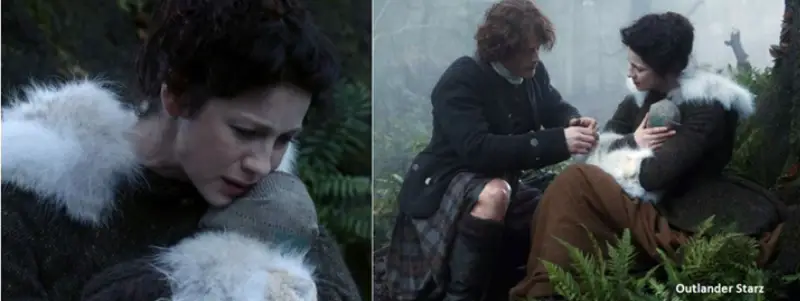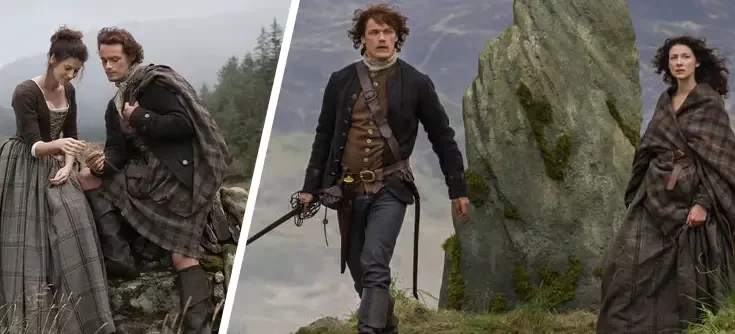Stone Circles and the Druids: Scotland has the most stone circles recorded of any country in the British Isles, at 508. It is believed that the standing stones served a ceremonial purpose, particularly in relation to solar and/or lunar alignments. [1]
Ancient standing stones, also called fairy hills, “mark a place on the earth where the powers of nature come together, giving it focus, and for certain people, on certain days, it allows them to pierce the veil of time,” enabling them to travel to another time, according to Mrs. Graham in episode 108. Frequently, the travelers return to their own time.
Gwenllin, the bard at Castle Leoch in 1743, sang a song of a man out late on a fairy hill on the eve of Samhain (Halloween), who hears the sound of a woman singing sadly from the rocks on the hill. As the legend goes, “The folk seemed to have stolen me over again. I stood upon the hill, and the wind did rise, and the sound of thunder rolled across the land. I placed my hands upon the tallest stone and traveled to a far, distant place where I lived for a time among strangers, who became lovers and friends. But one day I saw that the moon came out, and the wind rose once more. So, I touched the stones, traveled back to my own land, and took up again with the man I had left behind.”
Druids were religious leaders as well as legal authorities, adjudicators, lorekeepers, medical professionals, and political advisors. Although literate, they left no record of events, instead passing down knowledge verbally through generations in accordance with their doctrine. [2].

Fairies: These mythical beings are generally considered to be human-like in appearance and nature. Some theories link their origins to demons, pagan deities, spirits of the dead, or spirits of nature. Fairies have magical powers and a tendency to trick people. One common theme in all folktales is that fairies haunt specific locations and that charms are needed to ward them off. [3]
In episode 110, Claire, while walking with Geillis early one morning, hears the sound of a baby crying in the woods. Geillis tells her it is a changeling baby on the fairy hill and advises her to leave it alone. Claire goes to the hill and finds a baby in the hollow of a tree, but it is too late to save it. Parents of a newborn who is sick and not thriving believe that the fairies haven taken their baby, and left them a changeling. They ask for their own baby back by leaving in the changeling on the fairy hill, so the fairies can complete the trade. Jamie places the dead changeling back in the tree hollow so the parents will think it’s the changeling who died and that their baby is now healthy and living with the fairies.

Mythological creatures: Jamie sat with his head down… telling tales of selkies & seal-catchers, of pipers and elves, of the great giants of Fingal’s Cave…~Diana Gabaldon, The Drums of Autumn
Dominating folklore in the Highlands, these creatures are viewed as good or evil. Symbolizing “purity, innocence, and power in Celtic mythology, the unicorn is good, and is the national animal of Scotland [4]. Others, however, are thought to be able to transform their appearance, disguising themselves as many things, but with the sole purpose of luring humans to their doom.
Water horses, thought to lurk in lochs or lakes, are a shape-changing aquatic spirit that may appear as a tame horse on land. It is also said to inhabit Loch Ness. Kelpies are the same as water horses but live in turbulent water such as rivers, fords, and waterfalls [5]
Selkies are a mythological creature able to change between being a seal in the sea and becoming human on land by putting on or removing their sealskin.“ Selkies have a dual nature: they can be friendly and helpful to humans, but they can also be dangerous and vengeful.” Selkies can be tricked into marrying humans when a man steals their sealskin, preventing them from returning to the sea. Eventually, if the woman finds her skin, she may escape back to the sea. [6]

I hope you’ve enjoyed reading some of the folk stories passed down from generation to generation by the Scottish Highlanders and maybe learned something new at the same time.
References: [1] Wikipedia: Stone Circles; [2] Wikipedia: Druids; [3] Wikipedia: Fairy [4] National Trust for Scotland; The Unicorn; [5] Wikipedia: Water Horse-Kelpie; [6] Wikipedia: Selkie




